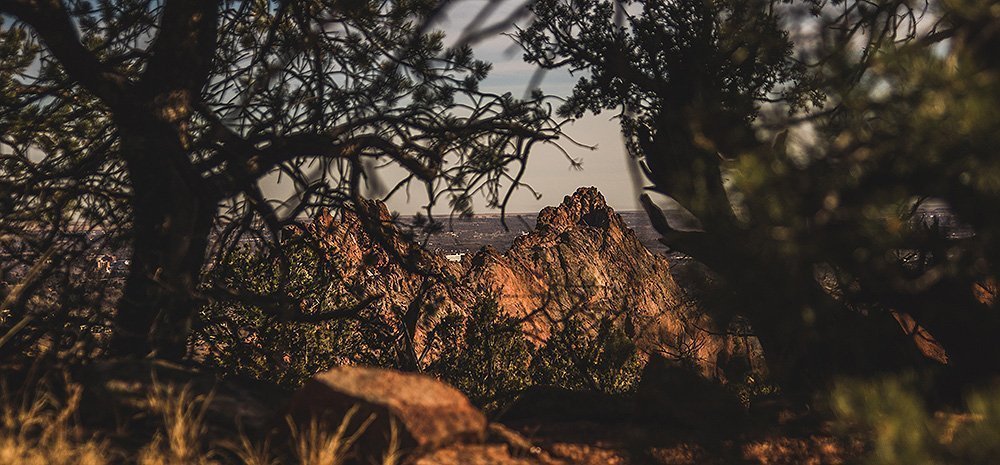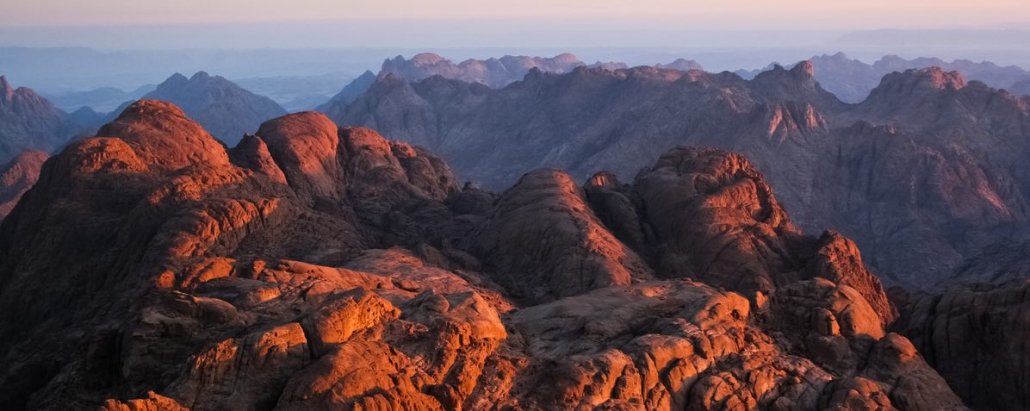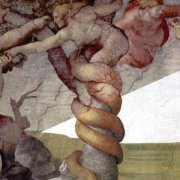From Sinai to Zion: The Story of the Bible, Told by Mountains
The stuff of earth is the stuff of life—and also the stuff of the biblical story. Trees, mountains, water, and food all figure prominently in the slowly unfolding drama of the Holy Scriptures. Now the fact is, there are lots of prisms for viewing the storyline of the Bible, many built from big theological concepts like covenant and kingdom. But it’s also possible to over-theorize the Bible, turning it into a collection of abstractions. But the Bible itself doesn’t do this. The Bible keeps its story close to the ground, making sure we remember it’s fundamentally a down-to-earth saga.
So, following the lead of the Scriptures themselves, we want to give you some takes on the big story from the perspective of four earthly elements of redemption. These windows into the Bible’s narrative of renewal are all the stuff of life. We’ve already looked at the story of trees. Today we’re scaling the heights, to see what mountains can tell us about the ever-advancing drama of the Scriptures. Next, we’ll explore how living water and the bread of heaven also play their parts.
The Story of the Bible, Told by Mountains
At over 4,300 miles in length, the Andes mountains are the western spine of all of South America and together constitute the longest continental mountain range in the world. The average height of its peaks is close to 13,000 ft. above sea level. I’ve climbed some mountains, and 13,000 is no small feet, or feat. The Andes, in a word, are imposing. They are a force, a dominating presence across seven countries.
By comparison, the mountains in my immediate neighborhood are modest. I suppose I could claim to live at the base of the mighty Rocky Mountains, a not-insignificant range of 1,900 miles running from the top of British Columbia well into New Mexico. But really, it’s more accurate to say that the rising ground out my back door makes up the foothills of the Rampart Range, which is itself merely the introduction to the Front Range, which is a small section of the Colorado Rockies.

Even so, I have to say that wandering around these unassuming hills is still awe-inspiring. There’s just something about mountains. Something about rising above everything else. Something about seeing over things. Something that’s difficult to communicate exactly. Peoples all over the world have always associated high places with heightened spirituality. Things feel different up there, especially when summits are reached. It’s the same in the Bible. Mountains, in fact, are right there at the heart of the story
God himself seems to have his favorites. “My mountain” he will say more than once, or “my holy mountain” or “the mountain of God.” He identifies with mountains. People in the story climb mountains to encounter the presence of God. Sometimes they’re met with thunder, lightning, and a certain terror, but other times it’s a soft, gentle whisper. Either way, God is there.
The biblical pattern with mountains fits into the broader setting of the ancient Near East. All across old world Mesopotamia numerous nations built ziggurats—hand-made, terraced temple-mountains with shrines and altars on top. This worldview saw the cosmos as a three-part structure: the heavens, the earth, and the dark places under the earth. The gods were believed to live in the heavens, above the high, domed shell that held back the great waters and created the open space above the ground. So mountains would be natural places to ascend closer to the gods and interact with them.
In the Bible, the biggest and best things happen on mountains. But also, as we’ll see, the hardest things. Mountains figure large in this saga.
At first, it seems all good. The ark of safety, surviving the great flood which covered the world, comes to rest on the mountains of Ararat. The first signs of earth’s renewed life come from the slopes of those peaks. And when old Jacob knew it was time to speak a good word over his sons, he told his beloved Joseph that all the blessings and gifts of the age-old mountains would surely rest on the head of this prince among his brothers.
The Bible’s poetry delights in going into great detail on God and the mountains. Eagles make their homes on rocky crags, perched there scanning far and wide for food. But birds of prey are not the only ones watching. God has his eye on the high places too, and he sees the mountain goats give birth, and the doe bearing her fawn. He knows every bird across the ranges, and even the insects are his. He is working always to make sure all of it—land, sky, peaks, clouds, rain, plants, and yes, the insects—works together for the flourishing of life.
So far, so good. But there’s more. The Bible has bigger mountains to scale, because not everything is well in the creation.

In a series of moments that will determine the redemptive pattern of the entire narrative, Moses comes to the mountain of God and meets the Holy One. The purpose of the encounter is for Moses to learn that God has surely seen the suffering slavery of his people. The Creator is the one who made the stage of history. He knows and cares about everything that happens there. He is determined that this suffering turn to singing.
The people need a new place, so he has a plan to bring them to a good and spacious land of their own, and also to a new mountain. He has a plan for bringing salvation into their story.
So Moses is enlisted in the effort, because this is a God of history and he does his work within history, through the regular means of history. God is an actor in the drama. So as soon as the new nation of Israel is marching out of Egypt, they march straight to the very same mountain of God.
Mountain climbing, however, is not for everyone. As the mountain was bellowing with smoke and fire and even trumpet blasts, God warns them, “Don’t touch it!” It’s going to take some work before the people are ready to meet God. But in a startling sign of things to come, Moses, Aaron, Nadab and Abihu, along with seventy of Israel’s elders, are invited up Sinai’s sacred hill to eat and drink with God.
Yes, to eat and drink with God.
This is exactly where God is taking the story—he wants all the people, people from everywhere, streaming to the great world-mountain of God so he can be their Rabbi. They need help. They need instruction. They need the Creator who made the world to teach them wisdom to live in the world. Then they too will feast with him.
History moves at the pace of real human lives. So God starts with Abraham’s family and one mountain.
But God isn’t doing everything all at once in this story, because that’s not how history works. History moves at the pace of real human lives. So God starts with Abraham’s family and one mountain. He brings Moses up for a time of extended teaching. He gives Moses all kinds of plans and instructions, including the design for something called a tabernacle. This is a kind of miniature model of the entire universe, a symbol of the whole creation, and it’s going to be God’s new home right in the midst of his people.
Turns out mountains are not only for people going up, but also for God coming down.
Next, God brings his people to that promised land of valleys and mountains, and it drinks in rain from heaven. It is a good place, set apart just for Israel. So God makes his home here with them, founding his holy Temple on a holy mountain. He rules over all the earth, but he rules from Zion.
Israel, however, quickly goes wrong in this would-be paradise. The people are climbing mountains now, but rather than meeting God they’re making idol-places on the hills and under every spreading tree. Those gods-that-aren’t-really-gods have captured their attention and their hearts. God has committed himself to Israel in a covenant bond, but he can’t have this.
So he pleads with the people, urges them, warns them—but to no avail. So the Lord has to prophesy against the mountains: “I will make the land a desolate waste, and her proud strength will come to an end, and the mountains of Israel will become desolate so that no one will cross them. Then they will know that I am the Lord.”
After devastation, the question still looms: Who may ascend the mountain of the Lord? Who can stand in his holy place? What of God’s longtime plan to save all peoples by saving Israel?
The answer is that God sends another mountain climber.
Many of the most significant events in the life of Jesus take place in the high places. First we read of Jesus regularly going up into the mountains, alone, when he needs to get away from the crowds and even his friends. Mountains are rest and sanctuary for him, and he prays there.
It is from a mountainside that Jesus appoints the Twelve to be his core group of followers. Moses-like, Jesus scales a mountain to deliver his own instructions for the renewing of Israel. He climbs again to actually meet with Moses and Elijah (representing the Law and the Prophets) about the culmination of his mission in Jerusalem.
Then, in three great mountain scenes, we see the anguish of Jesus on the Mount of Olives as he anticipates his suffering and death, followed by his brutal execution on a hill just outside of Jerusalem (the historian Eusebius identifies Golgotha as being just north of Mount Zion and the Temple), and then the joy of reunion when the resurrected Jesus meets his disciples on a mountain in Galilee.
Jesus has walked through the time of trial on behalf of Israel, on behalf of the world. Now he has emerged from the other side of exile into the life of the age to come. A new covenant is established. And it all happens on mountains!
When Jesus then travels back to the Mount of Olives with his disciples for the last time, he commissions them to extend his own mission. They are to be his witnesses. For Jesus the Messiah has descended from the highest heaven in order that he would ascend again and fill all things. He is the rock that smashes the world’s idols and calls all people to himself. All authority in heaven and on earth has been given to him, and the good news must be announced from the mountaintops.
Finally, John of Patmos shows us a vision of a day yet to come. An angel carries him away in the Spirit to a mountain great and high, and he sees the Holy City, Jerusalem, coming down out of heaven from God. And in this new heavens and new earth, the home of righteousness, there will undoubtedly be mountains, for God loves them—heights for us to climb, to rest, to worship.
Part 3: The Story of the Bible Told by Water >>>








